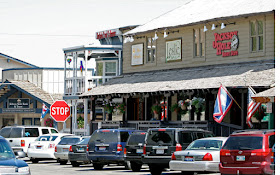We just got back from Jackson Hole Wyoming. It’s so nice in the there. We’ve been there before in the winter, but forgot how nice it is in the Autumn. Warm, clear and real Big Sky Cowboy Country. There’s arches of elk horns and stage coaches in the central square. The views of the Teton Range are magnificent from all over the Jackson Hole Valley. The Grand Tetons are a big part of what Jackson Hole is known for. The average altitude of the valley is over 6,500 feet (2,000 m) and the high peaks of the Teton Range rise more than 7,000 feet (2,135 m) above the valley floor.
Jackson Hole, originally called Jackson's Hole, is a valley located in the state of Wyoming, near the western border with Idaho. The name "hole" derives from language used by early trappers & mountain men, who primarily entered the valley from the north and east and had to descend along relatively steep slopes, giving the sensation of entering a hole. These low-lying valleys are surrounded by mountains and contain rivers and streams, which were good habitat for beaver and other fur-bearing animals. Today, this valley is an elk wintering ground and is located about three miles north of the town of Jackson.
The only real town in the valley is Jackson itself, sometimes also mistakenly called Jackson Hole. Other small communities in the valley include Wilson, Teton Village and others. On the west side of the valley, Teton Pass crosses the Teton Range leading to Victor and Driggs Idaho, on the western side of the Tetons. Numerous elk use the valley as grazing range during the winter.
Just over Teton Pass in Idaho is Grand Targhee Resort where we really had fun going up the back of the Grand Tetons on the chair lift in the middle of summer. Great fun and beautiful views.
We stayed at the Amangani hotel on the Gros Ventre butte just to the west of Jackson. It’s a true Aman hotel and it’s only one of two in the US. It's pretty difficult to find fault with anything about Amangani. The location is absolutely beautiful, perched on the butte overlooking a beautiful valley (with ranches and cattle) along with Jackson Hole and the Tetons in the distance. Overall, a very memorable stay at this Aman property. We have stayed there in both winter and summer and it is great. Can’t wait to get back.
There’s so much to do there which involves every thing from horseback riding and fly fishing to traveling to Yellowstone and The Grand Teton National Parks and much more…
All in all a trip to the Jackson Hole area is a great way to spend some time in The Big Sky Country. Highly recommended!















































